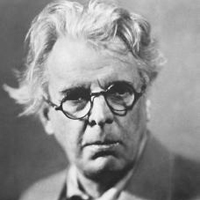Easter 1916 by William Butler Yeats: Critical Appreciation
Yeats's Easter 1916 is a profoundly ambiguous poem which strongly states that Ireland and the Irish people have been utterly changed. Yeats celebrates the memory of the general individuals who blindly sacrifices their lives in the Easter Rebellion despite the fact that they would certainly be defeated by the English government. Yeats, as a tribute to the martyrs, immortalizes them in his poetry by mentioning their names for their ability to transform themselves and the history of Ireland.

William B. Yeats (1865-1939)
Yeats, at first, doubts the patriots and their plans as he could not feel the serious commitment of patriotism in them. To him their cause was trivial and they just acted as revolutionaries. But after the revolution of Easter 1916 “A terrible beauty is born.” The beauty has been achieved at the cost of the lives of the great martyrs. Their sacrifice was doubted initially posing a question was it necessary. But later due to their sacrifice an utterly beautiful change is seen and felt in Ireland. The people of Ireland have been united for a great cause of national liberation. Through the event of Easter and the sacrifice of the general people to the national freedom, the lives of other people were greatly affected and changed. Through the revolution against the established ruling class, the speaker asserts that the people of Ireland have claimed for their independence and identity so as to procure their coming of age.
Yeats mentions the names of the martyrs who are really insignificant in normal lives to suggest that all the Irishmen have the potentiality and responsibility to evoke change. The poet deliberately illustrates the imperfections and human nature of the martyrs of Easter 1916 events so as to motivate the citizen stating that any heroic deeds are possible even for the average citizens if they passionately pursue change and justice. He demands for the need of the individuals to take active part in change and revolution for the sake of Irish identity for which many people sacrificed their lives.
Yeats has used powerful symbols to justify his stand as a supporter of Irish revolution. He symbolizes the stone in third stanza as a sign of permanence and immobility and the stream as a symbol of change and flux. The Irishmen have been living a stagnant and permanent life under the British colony just like a stone under the stream. They have been afraid to the change while the shadow of clouds in the stream changes minute by minute. The poet, moreover, implies that there are many countries opposing the British rule and declared their independence while Ireland has remained unchanged and senseless to their own identity. For the sake of Irish identity, he encourages the people of Ireland to forsake the conformity of the rigid stone and go for the change.
Yeats uses various rhyming pattern of iambic tetrameter and trimeter to emphasize on the specific elements of the poem’s content and significance. He mainly uses iambic tetrameter in stanza one and three but the lines 6, 8, 11 and 15 contain iambic trimeter pattern which vividly convey the message of triviality of Irish conformity to the British rule and the latest change that has developed in Ireland. In stanza five, Yeats deviates from the meter and rhyme pattern to focalize the loss of lives of his friends in the pursuit of change and identity. The mastery of handling of poetic language by Yeats conveys the significance of his message by maintaining consistency in abab form, he maintains the sense of unity; at the same time by allowing his structure to deviate, and he further focuses on message of Ireland’s coming of new era and the most awaited change and identity.
Cite this Page!
Sharma, K.N. "Easter 1916 by William Butler Yeats: Critical Appreciation." BachelorandMaster, 1 June 2017, bachelorandmaster.com/britishandamericanpoetry/easter-1916-critical-appreciation.html.
Related Topics
The Scholars: Critical Analysis
Sailing to Byzantium: Analysis
The Theme of Immortality in Byzantium Poems
A Prayer for My Daughter: Analysis
Among School Children: Analysis
Crazy Jane Talks with the Bishop
The Lamentation of the Old Pensioner
He Wishes for the Clothes of Heaven
An Irish Airman Foresees his Death
When You Are Old: Summary and Analysis
William Butler Yeats as a Symbolist
Truth of Human Life in Yeats's Poetry
Yeats and the Romantic Tradition
The Salient Features of Yeats's Poetry
Biography of William Butler Yeats
 |
bachelorandmaster.com |